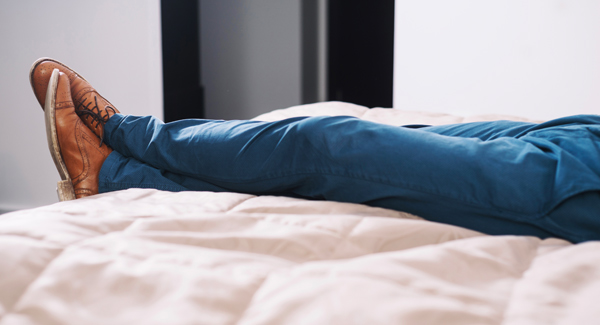Article navigation
- Published:
- Written by: Tony Brown
- Topic: Beds
There are many factors to consider when choosing a new bed. However, its overall height is something that is often overlooked.
Bed height matters because it affects how easily you get in and out of bed. This is especially important for older adults or those with mobility issues. The height of the bed can also impact the look and style of your bedroom. Low beds can make a small room appear bigger. Taller beds may work better in bedrooms with higher ceilings.
What is the ideal bed height?
The ideal bed height varies for each person because, in general, it should be proportionate to how tall you are.
To determine the ideal bed height, you should be able to sit comfortably on the edge of the mattress with both feet flat on the floor and your knees level with your hips. If your knees are above your hips, the bed is too low. If your feet can’t reach the floor, the bed is too high.
Does bed height affect comfort?
Over recent years, bed heights have increased significantly. They now typically range from 25 to 30 inches from the floor to the top of the mattress. This may present problems for older adults and those with mobility issues when getting in and out of bed.
A low bed can make getting out of bed difficult and put more strain on your joints and muscles. In contrast, a higher bed may force you to jump onto it, which could cause an injury. But higher beds are easier to get off as you can slide off to stand.
Getting in and out of bed comfortably may also be affected by the type of mattress. A mattress with a soft edge or that sags when you sit on the bed may be harder to get in and out of. But a mattress with a firmer edge may be easier to lift yourself onto.
What other factors affect Bed height?
Age
Appropriate bed height is often based on a person’s age. It may be more important for older adults to find a bed height within a specific height range. With higher beds, they may not have the strength in their arms or legs to lift them up onto the bed. Likewise, lower beds can be difficult to get out of.
There is an increased risk of falling out of bed with older adults. A lower bed can help limit the likelihood of injury.
Bed height is also important for children, particularly infants, when moving out of a cot into their first bed. A lower bed is easier for them to get in and out of and safer if they fall out of bed. As they get older, they may prefer bunk beds. Use guardrails on both sides of the top bunk and ensure there is enough clearance to the ceiling so that they don’t hit their head.
Mattress thickness
As most people buy the mattress separately from the bed base, it’s important to consider mattress thickness as this will affect the overall bed height. Most mattresses are around 10 to 14 inches deep.
A thicker mattress doesn’t necessarily mean it is of better quality. It all depends on the type of fillings within the mattress and the manufacturing process involved. For example, some mattresses may be compressed more in the factory.
Mattress thickness affects how easily you can get in and out of bed. It can also affect the overall look of the bedroom. For instance, a low bed with a thick mattress may hide the headboard. It may also be harder to sit up and rest your head against the headboard. Also, if the mattress is too deep, it may be harder to find suitably fitted sheets.
Finally, a deeper mattress may be harder to move into the room it is intended for, especially if there are access restrictions like narrow staircases, tight bends or low ceilings.
Types of bed
For many people, the style of the bed is more important than being able to get in and out of bed comfortably. Bed height should be appropriate for the size of the room. A lower bed is more in keeping with a modern bedroom and can make a small room feel more spacious. A low bed with legs is one of the best ways to achieve this, as it creates the illusion of more space. But with lower beds, under bed storage may be limited.
Taller beds may work better in bedrooms with higher ceilings but may appear big and bulky in a smaller room.
In some cases, bed height may not be a consideration. For instance, many bedroom furniture collections offer a limited choice of beds in the range. So if you want the bed to compliment the furniture, you’ll have to compromise on the height of the bed.
There are many different styles of beds. Each comes in a variety of sizes and heights.
Divan beds
A divan base is a box-shaped frame that is covered in material. They are available as either a platform top, or a sprung edge, with a spring unit mounted to the top of the frame.
When paired with a mattress, the overall height of a platform top divan set is around 20 to 22 inches, from the floor to the top of the mattress. Some bed manufacturers offer bespoke services, where the bed base can be manufactured to a specific height, typically in 6, 9 or 12-inch increments.
Sprung edge divans are typically taller to allow for the spring unit. They are usually around 25 to 30 inches from the floor to the top of the mattress.
Bed frames
There are many different types of bed frame, from modern to traditional, wooden to metal, each with varying heights depending on its style.
Ottoman-type bed frames that feature lift-up storage from the end or side are typically lower to the ground. In contrast, antique bed frames tend to be higher off the ground.
Some bed frames are also available with adjustable frame heights.
Adjustable beds
An adjustable bed is a good option for overcoming bed height issues, especially for older adults or those with medical conditions. The head and foot of the bed can be lowered or raised to a range of different sleeping positions. This can help the occupant get in and out of bed unaided.
Can you increase the height of a bed?
There are several ways you can add additional height to your bed.
Bed risers
Bed risers are ideal for raising beds to a height where you can comfortably get in and out of bed. They are placed under the legs or castors of the bed. They are available in various materials like plastic, rubber, wood and metal.
They also come in various colours to match your room décor. Bed risers are generally robust, stable and easy to fit. They come in multiple heights and can even be stacked on top of each other to provide extra height. It is essential to know the measurements of your bed legs or castors to ensure that the bed risers fit.
Bedstead base
A bedstead base is a shallow divan that sits inside a bed frame to support the mattress. It provides extra height to make it easier to get in and out of bed.
Available as either a solid top or sprung edge, a bedstead base can usually be made in various heights, depending on your needs. Bear in mind that the sprung edge version will be deeper to accommodate the spring unit in the base.
Mattress topper
A mattress topper rests on top of a mattress to provide an extra comfort layer. It may also provide some further height to your bed. The thickest mattress toppers are around 4 to 5 inches deep.
The topper fits your mattress with either elasticated corner straps or an elasticated skirt that stretches over the corners of the mattress like a fitted sheet.
Final thoughts
The ideal bed height should be relative to the person using the bed. Ideally, the safest and most comfortable bed height is one where you can get in and out of bed easily.
The importance of bed height will vary depending on a range of factors, which change as we get older. For younger adults, style may be more important. But as we get older and less mobile, getting in and out of bed comfortably should be a priority.
Share this article

About the author
Tony Brown is the founder and creator of The Bed Consultant. His career in the bed industry began in 2002. After graduating from university with a degree in Business Administration, Tony joined one of the largest independent furniture retailers in the UK as a bed consultant. Tony has helped thousands of customers find the perfect mattress.



